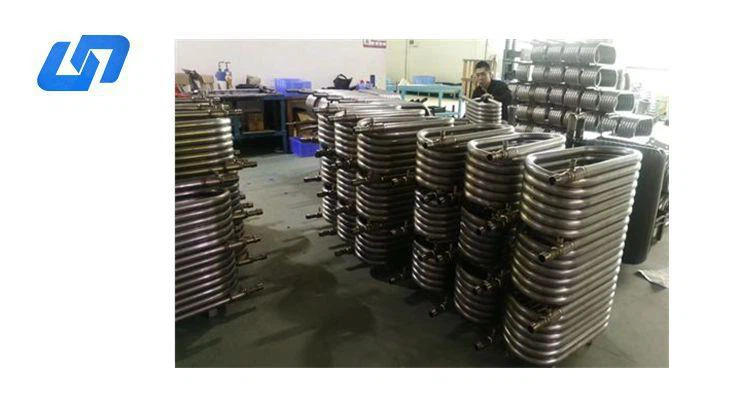
Titanium Coaxial Heat Exchanger
titanium coaxial heat exchanger and condensor
Oyter tybe:steel/copper/titanium
Inside tube:titanium, copper, copper-nicke
tube size:od19,OD21,OD38,OD42 or as request
Joint connection:copper tube and nut
MOQ:1PC
Product Introduction
Titanium coaxial tube heat exchanger is a type of heat exchanger that consists of two concentric tubes made of titanium. The inner tube carries the hot fluid, while the outer tube carries the cold fluid. The two fluids flow in opposite directions, allowing for efficient heat transfer between them.
The use of coaxial titanium heat exchangers offers several advantages over other materials. Titanium is highly resistant to corrosion, which makes it an ideal material for use in harsh chemical environments. Coaxial tube heat transfer is also very durable and can withstand prolonged exposure to high temperatures and pressures without degrading or corroding.
Advantages of using a coaxial coil heat exchanger include:
1. High efficiency: The coaxial design of the heat exchanger allows for efficient heat transfer between the two fluids, which can help to reduce energy costs and increase overall efficiency.
2. Corrosion resistance: Titanium is highly resistant to corrosion, which makes it an ideal material for use in corrosive environments. This can help to extend the lifespan of the coaxial coil heat exchanger and reduce maintenance costs.
3. Durability: Titanium is very durable and can withstand high temperatures and pressures without degrading or corroding. This can help to ensure that the heat exchanger remains operational for extended periods of time without requiring replacement.
4. Ease of cleaning: Titanium is easy to clean and maintain, which can help to ensure that the coaxial tube heat exchanger remains free of contaminants and operates at peak efficiency.
It is commonly used in various industrial processes, including in chemical processing, food and beverage production, and HVAC systems. They offer a high level of efficiency, durability, and corrosion resistance, making them an ideal choice for many applications where efficient heat transfer is critical.
Coaxial Heat Exchanger Specification
Nominal capacity 3.5KW-60kw
Inner tube material: Twisted Titanium/steel/copper tubes/copper-nickel
Outer tube material: Titanium / S: Stainless Steel (304/316L)/copper
Specification
Material | inner tube: Titanium/spiral tube |
Outer tube: Titanium, Stainless steel (outside) | |
Size | 19mm*0.6mm |
22mm*0.6mm | |
38mm*0.8mm | |
42mm*1.0mm… | |
Wall thickness | 0.55mm-3.0mm |
Refrigerant pressure: | 4.0Mpa |
Waterside pressure | 3.0Mpa |
Shape | Round, oval |
Refrigerant connection | Copper nut |
Water connection | Welded |
Refrigerant inlet&outlet | 12.7mm/19mm |
Water inlet&outlet | 32mm |
Use A coaxial "tube-in-tube" design. water flows through the inner tube while refrigerant flows in the annulus between the inner and outer tubes. | |
Feature
1. Water flow in the inner tube and refrigerant flow in the gap between the inner and outer coil, to enhance turbulence intensity and heat transfer efficiency.
2. Spirally corrugated inner tubes increase heat transfer surface to create higher efficiency.
Reliable with higher pressure stand and fewer welding points.
3. Anti-freezing and seld-cleaning titanium inner tube with high corrosion resistance
4. Enhanced groove line inner tube surface increases heat transfer efficiency by 30%
Application
Some specific applications of coaxial coil titanium heat exchanger include:
1. Heat recovery: coaxial tube heat exchanger are often used to recover waste heat from industrial processes and transfer it to other parts of the process where it can be utilized. This can help to reduce energy costs and increase overall efficiency.
2. HVAC systems: coaxial heat exchangers are commonly used in heating, ventilation, and air conditioning (HVAC) systems to transfer heat between air and water or other fluids. This can help to improve the energy efficiency of the system and reduce operating costs.
3. Chemical processing: coaxial coil heat exchangers are used in various chemical processing applications, including in the production of acids, bases, and other chemicals. They are ideal for use in these applications because of their high level of corrosion resistance and durability.
4. Food and beverage processing: coaxial tube heat transfer are used in various food and beverage processing applications, including in the pasteurization of milk and in the cooling of beverages. Their resistance to corrosion and ease of cleaning make them ideal for use in these applications.
Overall, the unique properties of titanium, including its high level of corrosion resistance and durability, make it an ideal material for use in coaxial tube heat exchanger. These heat exchangers have a wide range of applications in various industrial processes, where efficient heat transfer is critical to maintaining overall process efficiency and reducing operating costs.
Hot Tags:
You Might Also Like
Send Inquiry




